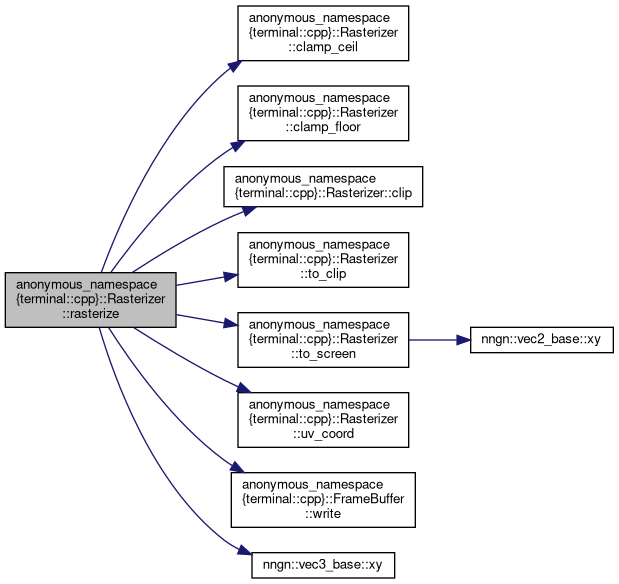Public Member Functions |
Private Member Functions |
Static Private Member Functions |
Private Attributes |
List of all members
anonymous_namespace{terminal.cpp}::Rasterizer Class Reference
Axis-aligned sprite rasterizer with texture sampling. More...
Public Member Functions | |
| void | update_projection (nngn::uvec2 term_size, nngn::uvec2 window_size, const nngn::Graphics::Camera &c) |
| void | rasterize (std::size_t vbo_n, const nngn::Vertex *vbo, std::size_t ebo_n, const std::uint32_t *ebo, std::size_t n_textures, const Texture *textures, FrameBuffer *framebuffer) const |
Private Member Functions | |
| std::array< nngn::vec3, 4 > | to_clip (nngn::Vertex v0, nngn::Vertex v1) const |
| Transforms world-space vertices into clip space. More... | |
| nngn::vec2 | to_screen (nngn::vec3 v) const |
| Transforms clip-space vertices into screen space. More... | |
Static Private Member Functions | |
| static bool | clip (nngn::vec3 bl, nngn::vec3 tr) |
| Checks whether a sprite lies entirely outside of the clip volume. More... | |
| static std::size_t | clamp_floor (float max, float v) |
Clamps value between 0 and max, rounds toward -infinity. More... | |
| static std::size_t | clamp_ceil (float max, float v) |
Clamps value between 0 and max, rounds toward +infinity. More... | |
| static float | uv_coord (float p0, std::size_t p, float p1, float t0, float t1) |
| Calculates texture coordinates for a given position in a sprite. More... | |
Private Attributes | |
| nngn::vec3 | size = {} |
| nngn::mat4 | proj = {} |
Detailed Description
Axis-aligned sprite rasterizer with texture sampling.
Member Function Documentation
◆ clamp_ceil()
|
staticprivate |
Clamps value between 0 and max, rounds toward +infinity.
Here is the caller graph for this function:

◆ clamp_floor()
|
staticprivate |
Clamps value between 0 and max, rounds toward -infinity.
Here is the caller graph for this function:

◆ clip()
|
staticprivate |
Checks whether a sprite lies entirely outside of the clip volume.
Here is the caller graph for this function:

◆ rasterize()
| void anonymous_namespace{terminal.cpp}::Rasterizer::rasterize | ( | std::size_t | vbo_n, |
| const nngn::Vertex * | vbo, | ||
| std::size_t | ebo_n, | ||
| const std::uint32_t * | ebo, | ||
| std::size_t | n_textures, | ||
| const Texture * | textures, | ||
| FrameBuffer * | framebuffer | ||
| ) | const |
Here is the call graph for this function:

Here is the caller graph for this function:

◆ to_clip()
|
private |
Transforms world-space vertices into clip space.
- Returns
- {bl, tr, bt, tt}: bottom-left/top-right vertices / texture coordinates
Here is the caller graph for this function:

◆ to_screen()
|
private |
Transforms clip-space vertices into screen space.
Here is the call graph for this function:

Here is the caller graph for this function:

◆ update_projection()
| void anonymous_namespace{terminal.cpp}::Rasterizer::update_projection | ( | nngn::uvec2 | term_size, |
| nngn::uvec2 | window_size, | ||
| const nngn::Graphics::Camera & | c | ||
| ) |
Here is the call graph for this function:

Here is the caller graph for this function:

◆ uv_coord()
|
staticprivate |
Calculates texture coordinates for a given position in a sprite.
Here is the caller graph for this function:

Member Data Documentation
◆ proj
|
private |
◆ size
|
private |
The documentation for this class was generated from the following file:
- src/graphics/terminal.cpp